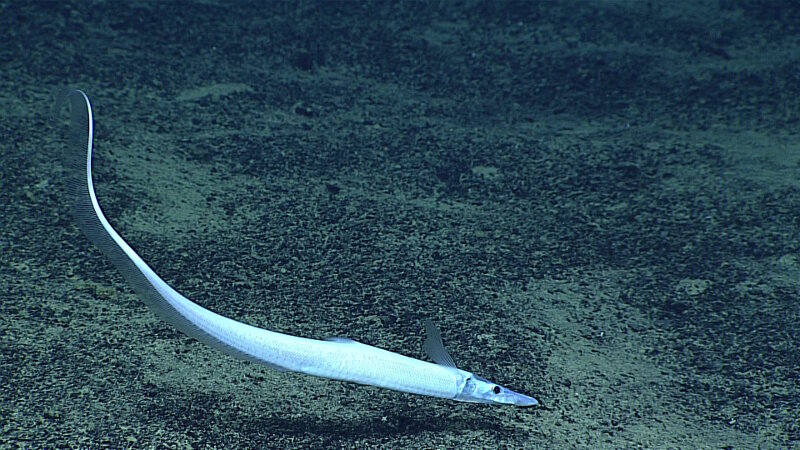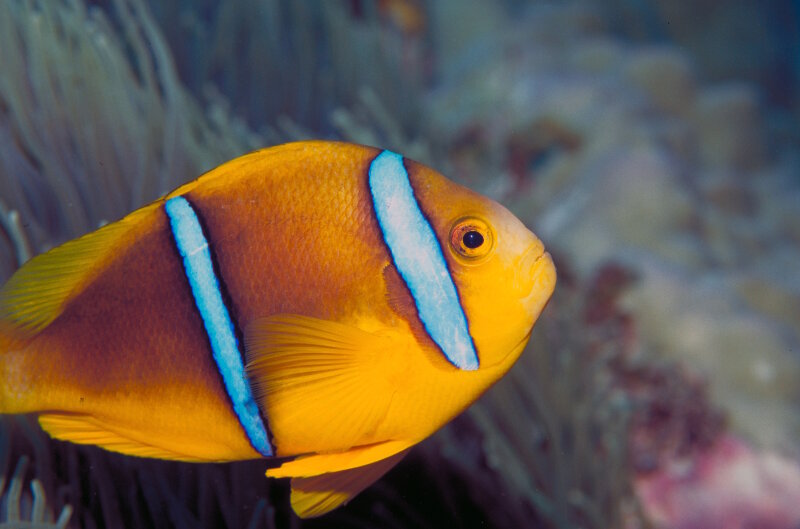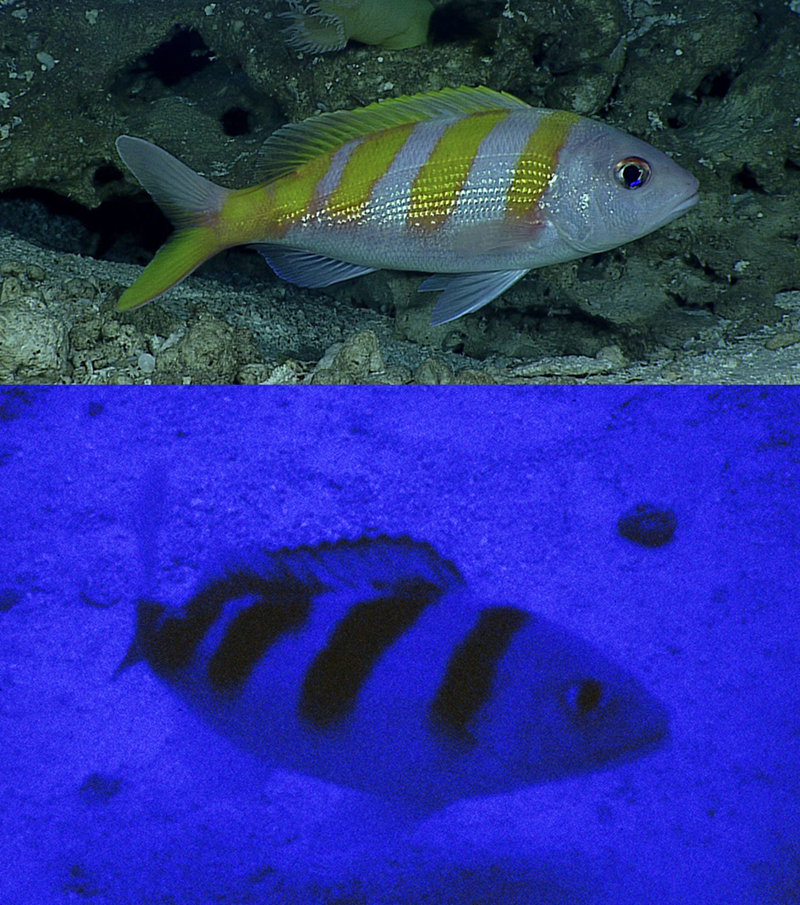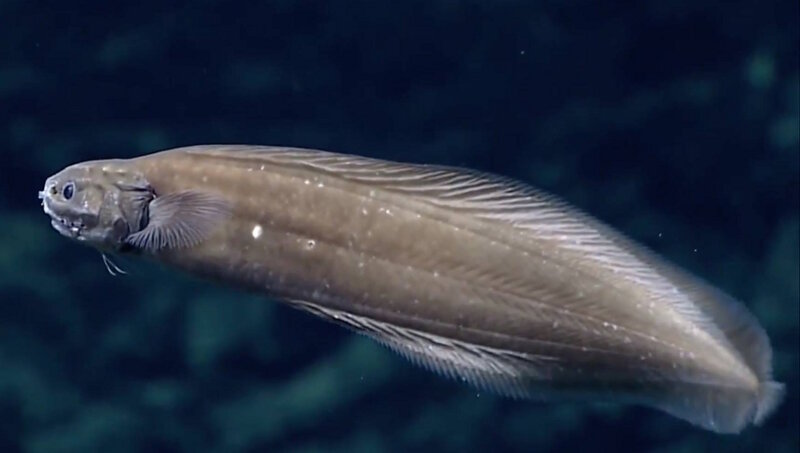
Bruce Mundy - NOAA National Marine Fisheries Service, Pacific Islands Fisheries Science Center
May 9, 2016

This pale, ghost-like spiny eel (Halosaurus species) was photographed at Fina Nagu Caldera C south of Guam (12.8°N, 143.785°E) between 1.6 and 1.7 miles (2,537 and 2,689 meters) down in the ocean. Its body lacks pigment, except for silvery cells, which appear shiny white in the lights of the ROV. The eyes are black and the internal areas of the head and gill cavity have darker pigment, making those areas light gray externally. Image courtesy of NOAA Office of Ocean Exploration and Research, 2016 Deepwater Exploration of the Marianas. Download larger version (jpg, 1.6 MB).
A pale wisp appears in the distance as the camera of the Deep Discoverer remotely operated vehicle (ROV) films the ocean floor of the Mariana Islands over a mile and a half deep. The ROV moves closer - the wisp undulates slowly. The shape of an eel or eel-like fish becomes visible and more detail is seen: an eye; a translucent head; and a diaphanous, barely visible, long fin along the lower edge of the pale, shimmering body. It is like a ghost of a fish.
In shallow waters of tropical Pacific islands, fishes that live in the open and are active during the day are brightly colored with vivid patterns that are unique to each species. In contrast, the fishes seen in Okeanos Explorer dives more than a mile deep are almost uniformly brown or gray. In even deeper areas, many are white because pigment cells are absent from the skin, but have dark eyes and gray areas at the head and gill cavities.
Why do we see this change in color with depth?

Many fishes living at sunlit coral reefs have distinctive patterns of bright colors, like this orange-fin anemonefish (Amphiprion chrysopterus) in shallow water at Saipan in the Mariana Islands. Image courtesy of Bruce C. Mundy, NOAA Pacific Islands Fisheries Science Center. Download larger version (jpg, 4.1 MB).
The answer involves light in the sea. The clear waters of tropical islands allow sunlight to penetrate deeper than the murkier, more productive waters of cooler areas. Coral reefs are famous for their brightly colored fishes.
Like deep-sea fishes, shallow-water fishes that live in murkier waters tend to be less colorful. Scientists have several explanations for this. The most obvious is that the bright, strong color patterns let the fish recognize others of their own species quickly and easily among the numerous fishes of the many species that live on reefs. In addition, males, females, and juveniles in some species have different color patterns that assist with mate recognition for spawning. And, strangely, bold patterns can be a kind of camouflage when fish move quickly to avoid predators. There are other explanations for the bright colors of shallow-water fishes, but all rely on the bright sunlight that makes them visible.
Sunlight is absorbed by water so the environment gets darker and different colors are progressively removed as depth increases. The colors are lost in order of their wavelengths. Red light, with the longest wavelength, is lost first, then yellow and green. Blue light, with the shortest wavelength, is absorbed last, and can be seen at low light levels surprisingly deep in clear tropical waters.

The oblique-banded snapper or gindai (Pristipomoides zonatus) lives in the twilight, or mesophotic, zone where only dim blue light penetrates. The upper picture was taken with the lights of a submersible illuminating the fish at 935 feet (285 meters) during an Okeanos Explorer dive at Farallon de Medilla, Mariana Islands; bright gold bars are seen on the body. The lower photograph was taken at St. Rogatien Bank of the Papahānaumokuākea Marine National Monument at 625 feet (190 meters) with the lights of the submersible turned off; the color pattern is still easily seen, but the gold bars appear black at ambient light levels. Top image courtesy of NOAA Office of Ocean Exploration and Research, 2016 Deepwater Exploration of the Marianas. Bottom image courtesy of Bruce C. Mundy, NOAA Pacific Islands Fisheries Science Center. Download larger version (jpg, 4.4 MB).
Many fishes in the twilight, or mesophotic, zone down to 1,600 feet (500 meters), where dim blue light persists, also have bright colors. Although the colors themselves are not visible in the dim light the patterns are visible, enabling species recognition, social interactions, mating, and the other functions of bright coloration in shallow waters.
Those color patterns no longer appear in fishes living below the depths where blue light is filtered out by the water. Below about half a mile (1,000 meters), there is not enough light for even the sensitive eyes of fishes to see full images, although many deep-water fishes can still detect bioluminescence, light produced by other animals for feeding or avoiding predators.
There is a transition in characteristic fish coloration going deeper from silvery fishes in the shallows to brown, black, or red fishes below the twilight zone (red appears black in dim light), and finally to pale brown or gray fishes below 2.5 miles (4,000 meters).

This unpatterned, brown cusk eel (probably an undescribed species) has color typical of many fishes living near the bottom between 0.5 and 3.6 miles (1,000 and 6,000 meters) down in the ocean. This fish was seen at Fina Nagu Caldera C, south of Guam at 12.8° North, 143.78° East, at 2 miles (3,200 meters) below the sea surface. The eye is large and can detect dim light produced by other animals, but it may not be able to see full images. Image courtesy of NOAA Office of Ocean Exploration and Research, 2016 Deepwater Exploration of the Marianas. Download larger version (jpg, 333 KB).
In the abyss, at 2.5 to 3.6 miles (4,000 – 6,000 meters) deep, and particularly in the hadal zone of the deep-sea trenches at extreme depths of more than 3.6 miles (6,000 meters), pale white or colorless fishes become the norm. At the greatest depths where fish live, most species are pale white.
The initial question has not been answered – why are the deepest-living fishes pale?
Certainly, the absence of sunlight has much to do with it. The functions of bright color patterns that work for shallow-water and twilight zone fishes don’t operate in the abyss and deeper. There is no need for the patterns.

This pale white cusk eel (Leucicorus atlanticus) was photographed at about 3.1 miles (5,000 meters) depth at Sirena Canyon, on the edge of the Mariana Trench. The head and body have internal pigment and the eyes are black, but pigment is otherwise absent. Dark pigment around the gill cavities and abdomens of deep-sea fish may mask light that is produced by recently eaten prey. The dark pigment in the eyes is necessary for vision. This species of fish lacks a lens in the eye, and thus cannot see images, but the large eyes are capable of detecting flashes of light produced by other animals. Image courtesy of NOAA Office of Ocean Exploration and Research, 2016 Deepwater Exploration of the Marianas. Download larger version (jpg, 1.3 MB).
Most deep-sea species evolved in lineages with drab, uniformly colored shallow-water relatives that are active at night; have other cryptic habits; or live in murky, cold-water areas. The drab colors and lack of distinctive patterns of many deep-water fish may be hold overs in their evolution from similarly drab shallow-dwelling ancestors.
Two other evolutionary explanations have been proposed for the very pale pigment in the deepest-living fishes. One, accepted through most of the 20th century, is that it takes too much valuable energy to develop pigment patterns in the deep sea where food is scarce. There has been natural selection for the loss of pigment. The other is that loss or retention of pigment doesn’t matter. Although white fishes in shallow water are highly visible targets for predators, there is no such natural selection that eliminates pale animals in very deep water. Deep-sea animals that have mutations preventing the development of pigment will survive and unpigmented species can evolve.
However, these remain suggestions. We know little about the vision of the deepest-living fishes that would influence the evolution of their color. The ghostly appearance of fishes in the abyss is another deep-sea puzzle in need of more exploration.